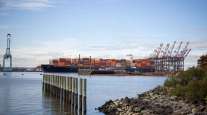Vancouver Port Celebrates Completion of Freight Rail Project

Port of Vancouver administrators, along with political and industry leaders, stood atop a small stage in a largely vacant marine terminal the morning of July 31 to celebrate the completion of the $251 million West Vancouver Freight Access project.
“We are building transportation infrastructure in this part of the state because this part of the state is integral to the economic growth of the entire state,” Gov. Jay Inslee told the crowd. “This project is as important to the economic development of Bellingham and Spokane as it is Vancouver.”
Throughout the celebration, workers rushed newly imported Subarus into an awaiting freight train in the background, and heavy equipment and engines groaned in the distance.

Inslee
“It really underscores what we do here and why we’re here today,” port Commissioner Eric LaBrant said.
What began as one project to give port tenants more timely access to trains in the mid-2000s mushroomed into an approximately dozen-year, quarter-billion dollar infrastructure investment. The port used its own funds and bonds to pay for about 71% of the project, while grants, tenant fees and BNSF Railway’s in-kind contributions paid for the rest.
The final price, $251 million, was $24 million lower than originally expected.
The overarching project was composed of 21 separate projects on various timelines, all centered on a new rail entrance, expanded rail corridors, a loop track and a new rail ramp. Collectively, they reduce rail congestion, add capacity and boost efficiency of rail service for port tenants and customers. It also allows the port to market its largely undeveloped Terminal 5, where a controversial oil terminal had been proposed before being rejected by Inslee earlier this year.
According to LaBrant, the rail project will create an additional benefit to the local airshed by reducing the amount of time trains spend idling in place, stuck in congestion.
U.S. Rep. Jaime Herrera Beutler (R-Battle Ground) described the project as innovative and timely, and anticipated it will have positive impacts for generations to come.
“The impact cannot be overstated,” she said. “It provided over a thousand new jobs and 4,000 construction jobs, and attracted more than $400 million in private investment … projects like this, to me, are a perfect example of putting our federal projects to work for all of us.”
While the event was a celebration of the overall project’s completion, most of its elements have been in use for several years. For example, the railroad ramp into the port was finished in 2008. It connects to another project called “the trench,” which was finished in 2015. Together they established a new grade-separated rail entrance into the port.
Early-stage construction of the West Vancouver Freight Access also included realignment of the rail along the Vancouver waterfront. That work enabled the city to punch Esther Street and Grant Street through the rail berm and reconnect downtown with the waterfront.
Augusto Bassanini, chief operating officer of United Grain Corp., which operates the largest grain export terminal on the West Coast, said, “The project will effectively improve transportation efficiency, reducing operating costs and increase our competitive position in the global marketplace.”
Looming over the port’s celebrated infrastructure upgrade are international trade policies being pursued by the Trump administration, which have created a lot of uncertainty for port tenants who operate in the global marketplace.
The Port of Vancouver is the second-largest importer of steel on the West Coast; workers unloaded nearly 713,000 metric tons of it last year alone. The port also moves about 10% of America’s wheat to international markets. Last year, nearly 2.6 million metric tons of wheat were exported from the Port of Vancouver.
In June, the United States imposed a 25% tariff on steel imports from Canada, the European Union and Mexico. Later, China imposed tariffs on agricultural products including soybeans, wheat and sorghum.
Port spokeswoman Abbi Russell said that while the port staff is marketing sites such as Terminal 5 to overseas customers, they hear about those concerns firsthand.
“It is certainly interesting timing,” she said. “The good news is the project is paid for. We have some bonds on it that we’ll be paying on over the years.”
Distributed by Tribune Content Agency, LLC




